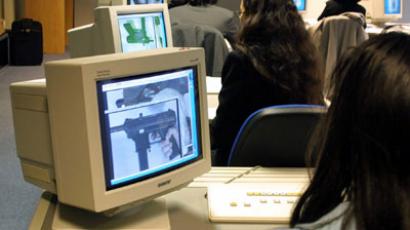3D printing revolution smells of gunpowder and more
Home manufacturing may well be the next technological revolution, changing our life as much as computers, mobile phones and the internet have. But the world may not be prepared when some of the consequences, such as printable weapons, arrive.
The promise of 3D printing technology was hailed by Barack Obama in his latest State of the Union speech in February.
“A once-shuttered warehouse is now a state-of-the art lab where new workers are mastering the 3D printing that has the potential to revolutionize the way we make almost everything,” the US president said, pledging to make sure that this revolution happens in America first.
In every house in a decade?
3D printers are devices that use digital models of objects to produce their real copies, printing them layer by thin layer over minutes, hours or sometimes days. Every year the technology is being refined, allowing better materials and more detail in the items produced.
The technology is becoming cheaper too. MakerBot, a major producer of 3D printers and at the forefront of the expected revolution, is selling its latest Replicator 2 desktop printer at a relatively accessible US$2,200, roughly the equivalent of a desktop computer. And it is overflowed with orders.
“The demand is much greater than our supply right now. We are actually ramping up and expanding rapidly to meet that demand,” the company’s PR Director Jenifer Howard told RT.
Soon a new device is to give a considerable boost. In March, MakerBot announced a prototype of a 3D scanner, which would be able to digitalize a real-life object and make it into a printable file. If that proves successful, entry to 3D printing will become much easier, with little requirement to learn computer-assisted design to get what you want. The already big database of models is likely to explode.

Home-made guns a piece of cake
But among those models you will likely find more notorious things than plates and card holders. Thingiverse.com, the popular repository of 3D blueprints, contains questionable items like bongs for smoking pot. What it does not contain is printable weapons, but not because they don’t exist.
Cody Wilson, a 25-year-old law student at The University of Texas School of Law in Austin is the person whose name comes to mind when 3D printed guns come up. For years the goal of the self-described crypto-anarchist and his followers was to create a fully printable firearm and make it available for everybody on the net.
Just like the printers, Wilson’s creations are getting better over time. The latest achievement of his Defense Distributed project demonstrated in March was a printed plastic lower receiver for an AR-15 semi-automatic rifle that can fire more than 600 rounds.
This part of the gun is essentially what makes a firearm a firearm. Everything else, including ammunition, is much less regulated and can be easily bought in the US. Other items he wants to make available to everyone are high-capacity magazines, which the White House seeks to ban.
The quest for little-controlled guns through new technology failed to win supports from traditional pro-gun lobbyists. The NRA has never officially commented on Defense Distributed efforts, but Wilson himself hardly expects an embrace of his anarchic stance. Still his organization acquired an arms producer license not long ago.
The mainstream 3D printing community is not thrilled with such projects, but many agree that the cat is already out of the bag. Information is notoriously hard to be removed from the internet, as any anti-piracy organization may witness. Wilson says his weapon files have been downloaded more than 400,000 times since he made them available on his website. Once 3D printers are as common as iPads, gun control as it currently exists may become obsolete.

Revolution without borders
Wilson says his crusade is all about freedom rights and goes far beyond the Second Amendment. He has recently launched a website called DefCAD, an alternative search for printable parts. It has the ambition to become The Pirate Bay of 3D printing, with a similarly global reach and the same attitude to regulations.
“DefCAD stands against artificial scarcity, intellectual property, copyright, patentable objects and regulation in all of its forms. If 3D printing is going to be developed as a technology, we need specific tools to help get around industry, government, and the collusive members of the maker community,” Wilson declares in a video announcing the search site.
“There will be no takedowns. Ever,” he states.
In an interview with Ars Technica he confirmed that DefCAD will resist takedown requests under the Digital Millennium Copyright Act and is prepared to move its operations away from the US jurisdiction. He mentioned Slovakia, Russia and Singapore as possible destinations.
The radical change he envisions includes easy-to-get home-made guns, medical devices, drugs and 3D printers themselves. If it comes true, the world will certainly be a different place. Unsafe and chaotic, critics say. With more freedom for everyone, supporters say. Certainly one to which many will have hard time to adapt.















